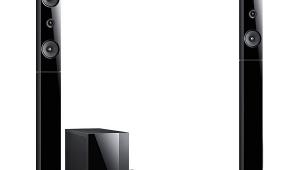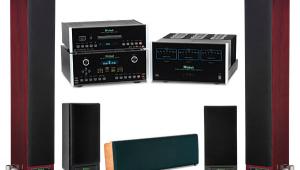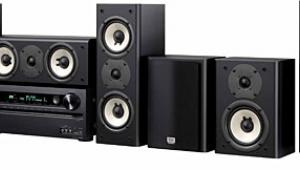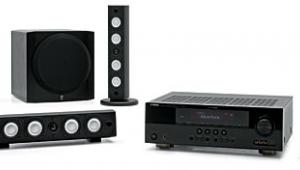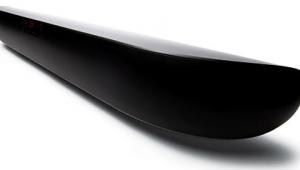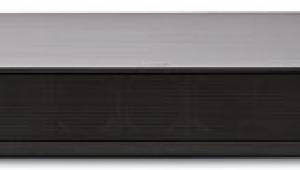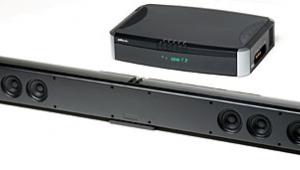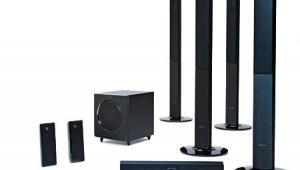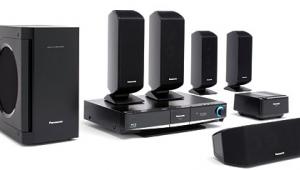Yamaha DVX-S100 HTIB Page 2
In progressive mode, the player measured out to about 500 lines of resolution, and it also passes PLUGE, which doesn't affect picture quality but makes it easier to set up your display. Another nice perk. I had no trouble with any of the CD-Rs/-RWs, MP3-encoded CDs, or DVD+RW discs that I ran through the player. Overall, Yamaha was very wise to include the Faroudja chip in this DVD player, as it certainly ups both the system's performance and its value.
For my audio demo, I began with two-channel music. In stereo mode, the DVX-S100 employs both the front satellites and the sub. You can turn off the sub, but I doubt you'll want to, as it serves up a solid amount of quick, well-defined bass without sounding boomy or intrusive. I was generally pleased with the little NX-S100S's performance. Like most of its HTIB brethren, it leans toward the bright end of the scale, but it never sounded harsh, and it provides a reasonable amount of midrange. The speakers do favor female vocals; but, in "Long Way Home" off of the Big Bad Love soundtrack, Tom Waits' infamous growl had more meat to it than you'd expect from such a small speaker. As the speakers are pretty revealing, the system tends to take on your source material's characteristics. Rage Against the Machine's "Bombtrack" sounded gritty with quick bass, while Lyle Lovett's "Here I Am" sounded relaxed and smooth, although the midrange horns were a little anemic.
Power is the Achilles' heel of many an HTIB, but not this one. When I switched over to the DPLII music mode and cranked the volume, this system stayed very clear, only hinting at compression in the densest passages, like the climactic percussion sequence in Peter Gabriel's "Rhythm of the Heat." I love the openness that DPLII lends to music. No, the DVX-S100 can't give equal weight to the entire frequency range in a song like U2's "Where the Streets Have No Name"—it just can't re-create the emotional intensity of that fantastic opening the way a pair of towers can—but this HTIB's amp/speaker combo allows it to do a better job than many in its class.
With movie soundtracks, the matching sats create a cohesive, lively surround soundfield. Because I live in an apartment, I happen to prefer less-room-shaking, more-articulate bass, so I was satisfied with the SW-S100's performance. Yamaha has kindly included the aforementioned level control, as well as a bass-boost setting, to let you tailor the system to suit your bass taste, but don't expect miracles. The depth-charge sequence in U-571 was solid but not earth-shaking.
 Interestingly, the center channel's tonal quality changes when you move off-axis. In the sweet spot, dialogue and other effects are pretty clear, although still too boxy for my tastes. Move to the right, and a noticeable cupped-hands effect occurs. This effect isn't as pronounced when you move to the left, but it's still noticeable. In truth, all of the speakers are a bit directional and sound their best in the sweet spot, so you may need to fiddle with their placement to get the widest, clearest soundstage possible.
Interestingly, the center channel's tonal quality changes when you move off-axis. In the sweet spot, dialogue and other effects are pretty clear, although still too boxy for my tastes. Move to the right, and a noticeable cupped-hands effect occurs. This effect isn't as pronounced when you move to the left, but it's still noticeable. In truth, all of the speakers are a bit directional and sound their best in the sweet spot, so you may need to fiddle with their placement to get the widest, clearest soundstage possible.
Pay attention, I'm going to save you a trip to the manual right here (since I know you're probably not gonna take my advice and read it all the way through): The Disc Direct function allows you to enjoy the high-resolution track on a DVD-Audio disc. I recommend that you set Disc Direct to turn itself on automatically (via a button on the DVR-S100's front panel), so the player will default to the correct mode when you insert a DVD-Audio disc. Once you're in Disc Direct mode, ignore any icons that appear on the front-panel display, as you're bypassing them. They'll only confuse you.
What can I say about the quality of DVD-Audio tunes? Obviously, a system this size doesn't re-create the live experience, but it does as solid a job as you can reasonably expect. Again, the DVX-S100's power goes a long way in making the DVD-Audio experience more enjoyable.
Perhaps the DVX-S100's strongest selling point is its upgradeability. The sub's cleverly designed speaker terminals allow you to upgrade both the speaker wire and the connecting speakers as your tastes evolve. I'd start with the center channel. You can set the receiver to small or large as your setup changes, too. The DVR-S100 receiver/DVD unit also sports six-channel preouts on the back panel if you want to move to a more-powerful amp but continue to utilize the system's great DVD player and processing modes.
Add to this upgradeability all of the DVX-S100's processing perks, that wonderful Faroudja chip, a solid speaker/amp package, and a price tag of $999, and Yamaha has definitely covered the bases in the HTIB game. If you're ready to step up to the home theater plate, you should add the DVX-S100 to your tryout roster.

Highlights
• Features galore
• Solid power output
